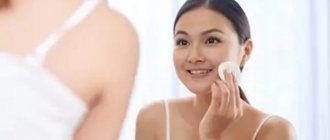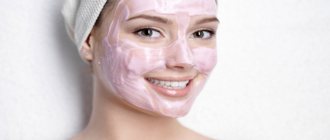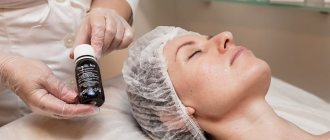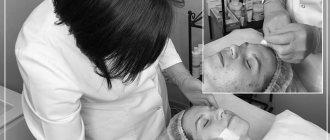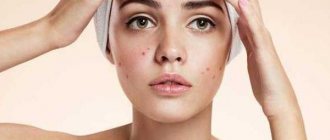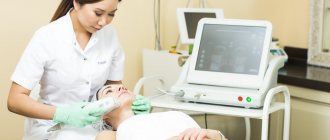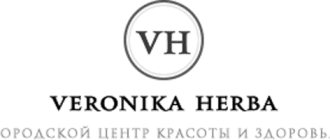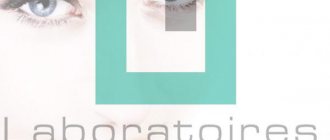Peeling is the removal of dead skin cells. This is the interpretation we mean most often. Although in cosmetology different types of procedures are used, some of which affect the deepest - even living - layers of the skin.
As a result, a healthy, rejuvenated appearance of the face returns: radiance, velvety, elasticity. Cosmetologists offer various options for skin resurfacing depending on the characteristics of the skin and the problems on it.
What is peeling
The main goal of any peeling is to exfoliate dead cells of the upper layer and stimulate the formation of new ones.
Often the process involves inevitable damage to the epidermis using various methods to enhance the result. The most common peels: acid, laser, abrasive.
The methods are well known, they can be combined, individually choosing the composition and concentration, ultimately obtaining the desired effect.
What problems does facial peeling solve?
Peeling can solve most aesthetic skin problems. The result is rejuvenation, regeneration of skin cells, enhanced nutrition, elasticity, and velvety complexion.
Indications for the procedure
- skin rashes;
- age-related skin changes – wrinkles, folds of the nasolabial triangle, “crow’s feet”;
- drooping eyelid;
- fatness and shine;
- skin irregularities;
- noticeable capillaries;
- scars, cicatrices, age spots.
Problems can be fixed. The main thing is the absence of contraindications.
The easiest way is to contact a cosmetologist, but the procedure does not cost three pennies, so some types of peeling can be done at home yourself.
The strongest and most effective at 20, 30, after 40 years
When choosing a type of facial cleansing, two most important factors should be taken into account: the client’s age, the level of skin aging and, of course, the problem that he hopes to get rid of.
- On the skin of patients aged 21–25 years, age-related changes do not yet make themselves felt, but pigmentation may already appear. Cosmetologists advise paying attention to gommage or scrub, enzyme cleansing, and peeling with fruit acids.
- At the age of 25–35, the first small expression wrinkles appear, keratosis (hardening and keratinization of the skin) and the appearance of pigment spots are possible. After 30 years, the most relevant are cryopilling, laser or superficial chemical peeling.
- In patients aged 35–50 years, age-related changes are already more noticeable: dull complexion, pronounced pigmentation and capillary meshwork. Experts recommend resorting to laser cleaning or vacuum peeling after 40 years.
- People over 50 are increasingly noticing many wrinkles and folds of varying depths on their faces. Women at this age will find deep chemical peeling and laser cleaning most effective.
What else to pay attention to:
- cosmetics containing milk components are more effective for dry and sensitive skin types;
- in the fight against unaesthetic age spots, the most effective method will be chemical exfoliation, but enzymatic cleansing does an excellent job with oily sheen and impaired sebum secretion;
- salicylic acid in the product is ideal for problematic skin types that are prone to inflammation;
- If the patient wants to achieve an even and radiant tone, microcrystalline resurfacing can be tried.
We recommend: What is the essence of carbon peeling, who is it indicated for, and when can it harm? Stages and nuances of rehabilitation
The effect of peeling
Facial peeling is a painful procedure, but not in all cases. There are gentle methods of facial cleansing - superficial. They will not bring profound changes, but they will cope with skin imperfections that have just begun to worry.
For more serious procedures, various methods of pain relief are used, but sometimes you will have to be patient.
The end result:
- smooth and moisturized skin;
- minimizing wrinkles, scars, post-acne, pigmentation;
- elasticity, healthy appearance;
- contour facelift;
- elimination of fat and shine;
- narrowing of pores and absence of blackheads;
- evening out skin tone and texture.
The effectiveness of peeling is obvious. The result must be maintained regularly (frequency depends on the type of peeling). Proper post-peeling care will prolong the longevity of the effect and prevent complications.
Before and after superficial peeling
Procedure carried out with retinoids
Retinoids are a group of medications that are multiple forms of vitamin A. Unlike other types of peels, retinoid peels do not cause immediate damage to skin tissue. Retinoids force the horny scales to peel off on their own, stimulating cellular receptors.
The drugs affect not only the epidermis, but also the dermis, stimulating cell regeneration and activating collagen production. After retinolysis, the stratum corneum becomes thin. But the overall thickness of the epidermis increases due to intensive cell division.
Retinoic exfoliation helps smooth out deep wrinkles and normalize the functioning of the sebaceous glands. Retinoids have an anti-inflammatory effect and enhance local immunity.
For superficial exfoliation, retinoic acid (tretinoin) is used at a concentration of 5-10% or retinol (5-7%). The composition for the yellow peeling procedure is prepared from retinoic, azelaic, kojic, ascorbic and phytic acids.
The exfoliating effect of retinoic peels is comparable to the results of fruit house procedures. However, unlike them, retinoids can be used to exfoliate skin with rosacea.
After a retinoic peel, patients sometimes experience irritation, dryness and tightness of the skin. More often, such phenomena occur after using retinoic acid.
Video peeling with retinoids:
Advantages and disadvantages
There are different peeling methods - superficial, medium and deep. This makes the effectiveness and risk of the procedures different.
Advantages of peeling
- superficial method of facial cleansing - painless and short recovery process, minimum complications;
- the middle method of facial cleansing - eliminating inflammation and rashes, scars and pigmentation, smoothing wrinkles, evening out the tone and texture of the face - the list is attractive and does not require injections or other invasive interventions;
- deep facial cleansing method - eliminating pronounced signs of skin aging, minimizing age spots, scars and scars - for aging skin this is simply a cure for old age.
In addition to the obvious advantages of peeling, there are also some disadvantages. They are related to the procedure, but much depends on the experience of the master.
Minuses
- superficial method of facial cleansing - such peeling will not eliminate serious skin defects; the effect is only after a full course of peeling – sometimes up to 10 sessions are required;
- the middle method of facial cleansing - complications are possible, there may be pain during the procedure, rehabilitation requires at least a week;
- deep facial cleansing method – the need for anesthesia, protection from ultraviolet radiation is important (up to 3 months after the procedure), painful peeling, risk of side effects, long-term rehabilitation.
Any procedure has both positive and negative aspects. The disadvantages can be minimized with the right approach.
What acids are used in peelings ↑
AHA acids
These are water-soluble acids and work better on the surface of the skin. Used to eliminate pigmentation (freckles, age spots). Most suitable for those with normal, dry or sun damaged skin. The names of alpha hydroxy acids reflect the primary natural source in which the substance was found.
ANA acids include:
- lactic acid - it is obtained from milk;
- mandelic acid - isolated from bitter almond extract;
- citric acid - from oranges and lemons;
- tartaric acid - from wine waste, grapes, oranges, potatoes, cucumbers;
- malic acid - from apples and pears;
- pyruvic acid - from fruits, honey, vinegar, as well as tartaric and lactic acids;
- glycolic acid - from sugar cane.
BHA acids
These include salicylic acid, isolated from willow bark or an aspirin derivative. Salicylic acid is fat-soluble, so it penetrates deeper into the skin, can exfoliate the surface layer of the skin, and also penetrate the pores (it dissolves in the fat layer). Therefore, it is more preferable for combination and oily skin, prone to the formation of inflammatory elements and clogged pores.
PHA acids
These are two acids: gluconic and lactobionic. Gluconic acid is produced naturally in skin cells in small quantities and is produced in the laboratory by fermenting pure glucose. Lactobionic acid consists of the sugar galactose and gluconic acid.
The peculiarity of PHA acids is the large size of the molecules, which do not penetrate deeply and work only on the surface of the stratum corneum. Their effect is more delicate and not as deep, so products with PHA are safe for sensitive, reactive skin.
Peeling classification
The peeling effect depends on the depth of exposure. As already mentioned, there are 3 groups into which facial cleansing is divided: superficial, medium, deep.
You need to do superficial peeling for smoothness of the face, medium peeling to eliminate minor defects and the first signs of aging, deep peeling to rejuvenate, even out the tone and texture of the face.
Sometimes peeling is called the simplest mechanical cleaning with abrasive substances - scrubbing, but this is not entirely correct. The purpose of the procedure is the same - to remove dead cells, but the scrub works very shallowly and does not reach full peeling. Use sea salt, grains of sugar, apricot and pomegranate seeds, eggshells
.
Chemical peeling involves the use of acids (fruit, salicylic, mandelic, trichloroacetic) and drugs (retinol, enzymes, enzymes). Once on the skin, they dissolve dead skin particles, provoking the formation of new cells. Depending on the type of peeling, the acid fights skin defects.
There are several options for classifying the procedure. Let's look at them all.
By depth of influence
Any method of facial cleansing involves damaging the skin. The only difference is how deep the damage occurs:
- Superficial – impact on the outer layer of the epidermis. The procedure is simple and painless and is often performed at home.
- Median - effects on the granular, spinous, basal and papillary layers of the epidermis.
- Deep - affects the outer layer and dermis to the middle of the mesh layer.
Medium and deep peels are painful. Their implementation requires professional training, since skin trauma occurs.
All procedures promote cell renewal. The result is elasticity and radiance of the skin, absence of dark pigment, inflammation and wrinkles.
Deep peeling requires a long recovery, the result is the most pronounced and lasting.
What kind of peeling do you use?
Superficial
The procedure is most often done using acids, especially mandelic, glycolic, salicylic (10%), and lactic.
Does not affect the deep layers of the skin, superficial cleansing is carried out. There is no discomfort during peeling.
At the initial stage, there may be slight redness and peeling, but the skin quickly recovers. After the procedure, the result is noticeable already on the 3rd day:
- healthy skin appearance;
- lightening pigment spots;
- even face tone and relief;
- wrinkles are smoothed out.
Superficial peeling is used to eliminate skin problems of any skin. To enhance the effect, vitamins, moisturizing components, and whitening agents are used.
Median
Medium facial peeling affects the skin up to the papillary layer.
This method involves the use of acids: salicylic (25%), retinoic, trichloroacetic (TCA). Multi-component medium peels are popular: Jessner, Hollywood, carbon, PRX-T33.
Thanks to medium peeling, the following is observed:
- skin radiance;
- elimination of pigment spots;
- thinning of scars and scars;
- fight against post-acne and acne.
After the median method of exposure, redness and swelling are immediately observed. Then active peeling and sometimes itching are added. Redness goes away within 10-14 days (sometimes longer), peeling lasts about a week.
During medium peeling, it is important to distract your hands so as not to scratch your face and tear off scabs, otherwise the effect will not be what you need. Rather, on the contrary, frequent touching of the skin will give side effects: inflammation and scars.
Deep
Deep peeling is performed in a medical facility under general anesthesia.
The main active ingredient is phenol. Immediately after the procedure, pain is felt, the face has a dark red tint, swells, and becomes covered with a thick crust.
The sight in the first days after the procedure can terrify an unprepared person.
For at least a month after peeling, redness, swelling, and very severe peeling remain.
But gradually the skin takes on a natural appearance. And in the mirror a face appears 5-10 years younger than the “pre-peeling” one.
The effectiveness of the procedure is expressed by:
- even tone and facial relief;
- eliminating wrinkles, even some deep ones;
- skin radiance;
- lack of pigmentation.
An important period after peeling is rehabilitation. If you do not adhere to the strictest rules, then side effects appear: pigmentation, inflammation with suppuration, allergies, scarring of the skin.
By method of influence
This classification method implies differences in peelings based on the method of implementation and impact. The active ingredient is also different.
Depending on the depth of action, it is determined where to perform the manipulations - in the salon or at home.
Aggressive substances and acids are used in clinics, gentle methods are used independently.
Chemical
Chemical peeling is a method of removing the outer layer of skin using special substances. Almost all types of chemical exfoliation involve acids.
Carefully! Acids can cause burns of varying severity.
- lactic – the active substance is lactic acid. Restores the thickness of the stratum corneum and acid-base balance;
- almond – the active ingredient is mandelic acid. Strong peeling of keratinized cells eliminates redness. Acid substances cannot penetrate the lower layers of the epidermis due to their size, and therefore do not cause severe irritation;
- salicylic – the active substance is salicylic acid. Reduces the number of wrinkles, removes post-acne, evens out the tone and texture of the face, restores oxygen supply to cells, resulting in elasticity and a healthy appearance of the skin;
- ferulic – the active substance is oic acid. Lightens wrinkles, eliminates dark circles and age spots. The composition contains a large amount of vitamins and microelements, due to which a positive effect is observed;
- azelaic – the active substance is azelaine. Removes the stratum corneum of the skin, fights inflammation and rashes, brightens the tone;
- "Bloody" has a red gel texture. Contains glycolic, lactic, tartaric, citric, salicylic acids, as well as other soothing components. It is recommended to apply in an even layer, avoiding the area around the eyes. As a result, exfoliation and lightening of the skin, evening out tone, eliminating oily sheen;
- pyruvic – a special preparation based on pyruvic acid. Fights rashes, blackheads, age spots, rough skin;
- glycolic – component glycolic acid. Thins the top layer of skin, lightens pigmentation and blackheads;
- Hollywood - consists of retinoic, azelaic, kojic acids. It has a yellow tint. Fights signs of aging and post-acne;
- phytic – substance phytin. Penetrates deep into the skin, eliminating signs of inflammation. The skin takes on a healthy and radiant appearance. The combination of acid with calcium chloride leads to the elimination of dirt and dead cells;
- PQ Age – the substance plastoquinol. Helps restore and cleanse the skin. Efficiency is manifested by elasticity, elimination of wrinkles, cell regeneration, even cleansing of the lower layers of the skin;
- retinoic - a drug with vitamin A. Does not work with immediate damage to the skin. The substances in the composition promote the independent exfoliation of the stratum corneum, enhancing cell division and collagen production. As a result, wrinkles are barely noticeable and oily shine is eliminated;
- Jessner peeling - consists of hydroacids, as well as lactic, salicylic acids and resorcinol. Penetrating into the skin, it triggers peeling of the upper layer of the epidermis and cell regeneration. The skin becomes lighter, the relief is evened out, redness disappears;
- TCA – active substance trichloroacetic acid. Cleaning is often done in specific areas: wrinkles, age spots or post-acne;
- PRX-T33 – contains trichloroacetic acid 33% (relieves inflammation, regenerates cell growth), hydrogen peroxide 3% (disinfects, saturates cells with oxygen), kojic acid 5% (brightens tone, adds elasticity);
- ABR peeling – retinol component. Removes dead particles and oily shine, enhances cell division, gives the skin radiance and velvety, eliminates inflammation and rashes, moisturizes the skin;
- phenolic – phenol component. Acts deep inside the epidermis, regenerating dermal cells. As a result, elasticity and relief from wrinkles.
The method of application for all types of peeling is similar: cleansing the face, anesthetizing (if necessary), applying the selected peeling, maintaining the required amount of time, neutralizing the peeling composition, applying a mask and moisturizing with cream.
Enzymatic
Enzyme facial cleansing differs from other types of chemical peeling. Enzymes are involved in the process.
These are natural elements that enhance or slow down processes in the body. There are several types of them, differing in action. Enzyme peeling uses hydrolases (proteases, cadrohydrolases and lipases) that break down proteins, fats and carbohydrates.
This cleansing reduces the stratum corneum and evens out the skin texture. Due to their large size, enzymes cannot penetrate deep into the epidermis. But thanks to a wide spectrum of action, cell regeneration occurs in the upper and lower levels of the skin.
Mechanical - microdermabrasion
Mechanical peeling includes the use of abrasives: diamond, coral, and titanium dioxide.
Diamond is applied using a vacuum nozzle with a core coated with diamond dust. Removes dead skin cells from the epidermis with a gentle effect on the skin.
Coral treats post-acne, redness, scars and age spots. The method is safe; it contains natural coral chips containing 1% glycolic acid.
Powdered titanium dioxide is also used, which is supplied to the epidermis under pressure through a nozzle. The intensity is adjusted by the cosmetologist. The method is used to eliminate scars and scars. Peeling is quite aggressive.
Laser
The laser cleaning method involves exposing the skin to a laser beam. There are several types of procedure:
- Cold – penetration into the stratum corneum of the epidermis.
- Hot – dead cells are gradually removed with gradual heating of the lower structures.
- Resurfacing – impact on the middle and deep layer of the skin. The device removes old cells, resumes the growth of new ones, and increases the production of collagen and elastin.
Laser peeling is not recommended for contraindications: oncology, problems of the cardiovascular system, inflammatory processes on the skin, pregnancy, poor blood clotting, weak immunity.
Carbon
The composition for carbon peeling resembles molten activated carbon. The procedure is gentle. But the result is good: dead cells are eliminated and the relief of the face is evened out.
After applying the mask with carbon dioxide, the laser begins to work. This combination enhances the effect of both carboxylic acid and laser, penetrating into the deep layers of the dermis.
As a result, the following effect is achieved:
- the stratum corneum disappears faster;
- cell division accelerates;
- the production of collagen, elastin and hyaluronic acid is enhanced;
- oily shine is eliminated, pores are narrowed;
- The tone and contour of the facial skin is evened out.
The process takes about 30 minutes. After anesthesia, a carbon mask is applied. After drying, the laser is turned on, and there is no pain.
Brossage (brushing)
Brossage is a safe cleaning method. The procedure is performed with a special apparatus with attachments - brushes, which quickly rotate in different directions. The brush removes dead cells, leaving the skin smooth and elastic.
Brossage helps get rid of rashes, enlarged pores, oily or dry skin, and expression lines.
Creopilling
Creopilling is the use of cold substances (nitrogen, dry ice).
Exposure of the skin to cold for 15 seconds leads first to a narrowing and then to an expansion of skin blood vessels. This results in a kind of vascular training. As a result, blood supply increases and the general condition of the epidermis improves.
With prolonged exposure to cold temperatures, the death of the upper skin cells is observed. This stimulates the formation of new cells, and the production of collagen and elastin is initiated.
Vacuum
Painless deflagration is performed by a special device responsible for eliminating contaminants. There are several vacuum peeling techniques:
- Massage with special attachments or a mechanical bulb. Upon contact with the skin, a vacuum environment is formed. Skin absorption generates increased blood supply and minor injuries, thus activating cell renewal.
- Classic peeling occurs using a device with a drainage tube. It promotes the absorption of dirt and sebaceous deposits. As a result, the skin is enriched with oxygen and a lymphatic drainage effect is achieved.
- Hydropeeling - using spiral attachments. Serum enters through a special hole, and the tube maintains optimal pressure. At the same time, dead cells disappear and the pores are cleaned.
- Diamond vacuum peeling involves the use of a diamond-coated suction device. The method is complex and can only be done in a cosmetologist’s office. The goal is cleansing and rejuvenation.
All methods are effective, the main thing is to choose the most suitable one. Depending on the problem and the presence of contraindications, it is advisable to consult a cosmetologist.
Ultrasonic
During the exposure process, the ultrasonic wave destroys the stratum corneum of the skin, penetrating deep inside, pulling out sebaceous deposits and blackheads. This accelerates blood supply and cell regeneration.
Ultrasonic peeling is performed at any time, regardless of the season. The technique is effective for inflammation, rashes, blackheads, facial wrinkles, pigmentation, and swelling.
Gas-liquid (Jet Peel)
Gas-liquid peeling is accompanied by cleansing and facial massage. A special program regulates the intensity of the impact.
Oxygen and carbon dioxide contained in the nozzle enter the skin, forming a small crust. The method allows you to quickly cleanse your face. Gas-liquid peeling eliminates sagging skin, wrinkles, circles under the eyes, rashes, pigmentation and scars. Very popular lately.
Fractional thermolysis
The main difference from laser peeling is that peeling acts pointwise, locally, only on problem areas.
The depth of penetration is set by the program and can change during the procedure. Fractional thermolysis eliminates wrinkles, blackheads, scars and scars.
Superficial, as one of the types of chemical facial peeling
The easiest and safest type of chemical exfoliation is superficial peeling (rolling, for example). It removes skin cells within the uppermost layer of the epidermis - the stratum corneum.
This layer consists of horny scales (corneocytes). Corneocytes are dead skin cells. They are the basis of the epidermal barrier of the skin. The stratum corneum protects tissues with living cells from damage.
The upper rows of corneocytes are loosened. They easily peel off on their own during human activity. If the exfoliation process is disrupted, dead cells accumulate and the thickness of the stratum corneum increases. In this case, the skin looks rough and dull, it takes on an earthy tint. You can find out which peeling is the most effective here.
Lack of timely exfoliation is often observed in women after 40 years of age. With the help of superficial peeling, you can remove “retained” corneocytes, reduce the thickness of the stratum corneum and improve complexion. After the procedure, fine wrinkles that appear as a result of natural aging or photoaging (under the influence of sunlight) disappear. This includes almond peeling.
Video of superficial chemical peeling:
Superficial peeling is recommended for young girls suffering from comedonal and papulopustular acne. Removing the top rows of corneocytes helps clean out the pores and normalize the functioning of the sebaceous glands. Superficial exfoliation can make age spots less noticeable.
The degree of exposure of the skin to acids depends on their concentration, exposure time and individual characteristics of the skin.
Which peelings are best done in which season?
Some peelings are suitable for any time, but there are few of them and they are always superficial. Typically, each procedure must be carried out in a certain season.
- winter is the time for medium and deep peels. They use TCA, phenol, pyruvic, azelaic, glycolic, microcrystalline dermabrasion, laser cleaning and other types that require long-term recovery;
- spring - there is a lack of vitamins. Fruit, coral, phytin peels and cryotherapy can restore facial skin;
- summer - superficial peels are in demand, which include milk, almond, salicylic and ferulic. If there are no special skin problems, such peelings are appropriate in any season;
- autumn – fruit, enzyme, glycolic and retinoic peels will help with dryness and tightness.
Pyruvic, azelaic, ferulic, phytic, kojic, trichloroacetic and retinoic acids.
In addition to AHA, BHA and PHA acids, other acids are also used that are not included in the chemical structure of these groups. Let's look at the most commonly used of them.
Pyruvic acid
A ketoacid with a high degree of fat solubility. As a result, the acid has great penetrating ability, therefore it is used to treat acne, seborrhea, and hyperpigmentation. When interacting with the skin, it partially undergoes hydrolysis and turns into lactic acid. Neutralization is recommended. In cosmetology, the standard concentration of pyruvic acid used is 40%.
Azelaic acid
It is a carboxylic acid. Azelaic acid slows down the formation of keratinocytes, has anti-inflammatory and antioxidant properties, and blocks melanin synthesis. Regulates disrupted keratinization processes in the excretory ducts of the sebaceous glands, thereby cleansing the gland ducts. Contained in small quantities in the human body, synthesized during lipid metabolism. Used to treat acne, seborrhea and pigmentation. In peeling compositions it is found in a concentration of 15-20%.
Ferulic acid
Representative of hydroxycinnamic acids. It is a powerful antioxidant and stabilizer of Vitamin C. Ferulic acid is also known for its ability to neutralize free radicals already formed as a result of UV radiation. In addition, the acid prevents the formation of free radicals in the body. Ferulic acid has protective and healing properties, can block excess melanin synthesis and reduce the risk of hyperpigmentation. According to research, ferulic acid also has a pro-apoptotic effect in skin cancer cells. The standard acid concentration for chemical peeling is 12-15%. A distinctive feature of ferul peeling is the appearance of a light white mask. Neutralization is not required. Thus, ferulic acid is a unique substance that shows positive results in the fight against problems such as photoaging, melasma, chloasma and acne.
Phytic acid
In fact, it is an ester of the cyclic hexahydric polyalcohol myo-inositol and six orthophosphoric acid residues. Due to its molecular weight, phytic acid does not enter the middle epidermis, but works on the surface, exfoliating the stratum corneum. The acid also has pronounced brightening and anti-inflammatory properties, therefore it is effective in the treatment of acne and hyperpigmentation. By exfoliating the upper layer of the epidermis, phytic acid stimulates the synthesis of elastin and collagen, which helps improve skin turgor. Phytic acid works at lower pH at high concentrations. Side effects are extremely rare when using phytic acid, so phytic acid peels provide more interesting results from the procedure compared to AHA acids, which can cause sensitizing effects, irritation and significant redness.
Kojic acid
Hydroxyl derivative of γ-pyrone, obtained from various types of mushrooms. The main function of the acid is skin whitening, due to the substance’s ability to inhibit the enzyme tyrazinase, which is involved in melanogenesis. The effectiveness of the acid can be enhanced by combining it with other brightening components: vitamin C, arbutin, glycolic and lactic acids. Kojic acid is also used to lighten skin if you are intolerant to hydroquinone. Typically used in combination with other acids.
Trichloroacetic acid (TCA)
Substance of the carboxyacid group. It is a halogenated analogue of acetic acid. TCA has pronounced keratolytic and stimulating effects. How deeply the acid penetrates the skin depends on the number of layers applied. Trichloroacetic acid is immediately neutralized as it moves through the layers of the skin, causing protein coagulation. TCA is perfect for correcting defects such as scars, post-acne, acne, wrinkles and other skin texture disorders. For exfoliating purposes, concentrations of 15 to 50% acid are used. Peeling concentrations greater than 25% can only be used in sterile conditions with the possibility of rehabilitation in a medical facility.
Retinoic Acid
Metabolite of vitamin A1. Retinoic acid is also known as the “Yellow” peel. It has unique properties, thanks to which it is popular in cosmetology and dermatology. Accelerates cell renewal processes, regulates the functioning of the sebaceous glands, fights acne, increases skin firmness and elasticity, normalizes melanin synthesis, increases the level of mitotic activity of basal keratinocytes, and activates the synthesis of components of the intercellular matrix of the dermis. To enhance exfoliation, it is used together with Dimexide solution. In cosmetology, peeling concentrations from 3% to 10% are used. Despite the large list of positive properties, retinoic peeling must be used with great caution. The acid can cause severe erythema, irritation and allergies.
Sources: https://www.martinex.ru/, https://theblueprint.ru/, https://cosgroup.com.ua/, https://skin.ru/, N.V. Chebotareva. Handbook for cosmetologist.
Breakdown of peelings by age
Any of the peels does an excellent job of cleaning the skin. But age leaves its mark, forcing the use of increasingly deeper procedures.
Facial peeling up to 25 years
Young skin is full of life and energy. There are no age problems yet. The only things that bother me are pimples and comedones.
To solve problems, superficial peeling is used, which carefully removes the stratum corneum of the dermis, cleansing and toning it.
For the earliest lovers of cosmetology, from the age of 15 you can do glycolic peeling, which allows you to get rid of rashes and blackheads.
Peeling in the period 25-35 years
At this age, the first stage of skin aging begins: pigmentation, facial wrinkles, minor changes in skin texture.
Superficial and medium peeling is used using acids (fruit, glycolic, lactic, almond, Jessner peeling).
With their help, you can save yourself from freckles, age spots, wrinkles - the skin will become elastic and velvety.
Peeling at 35-45 years old
Wrinkles, age spots, rosacea, redness, rosacea - no matter how much you would like it otherwise, characteristic features of skin aging appear, noticeable from the age of 35. You can also watch:
- vascular network,
- folds of the nasolabial triangle,
- wrinkles on the forehead, chin, around the eyes, neck, between the eyebrows;
To eliminate such age-related changes, any medium peeling, vacuum, laser, or cryopilling is suitable.
The top layer of facial skin is removed, activating the formation of new cells. This smooths out wrinkles, evens out skin tone, and increases the production of elastin and collagen.
Peeling at 45-55 years old
Skin aging is more noticeable. This is expressed by deep wrinkles, age spots, drooping eyelids, sagging, and changes in tone.
In this case, in addition to medium peels, you can think about deep phenol peels. The effectiveness of the procedure is expressed by the elimination of deep wrinkles and scars, skin elasticity, cell regeneration, skin softness, and tightened facial contours.
Peeling at 55+
Deep wrinkles all over the face, sagging skin, bags under the eyes, ptosis are constant companions of the face, starting from the age of 55.
You can rejuvenate your skin with medium and deep peels. As a result, elasticity increases, facial contours are straightened, wrinkles “bounce”, and pigmentation is smoothed out.
AHA – acids for superficial peeling
Some types of chemical facial peels are performed using alpha hydroxy acids. Alphahydroxy acids (Alfa - Hidro - Acid, abbreviated as AHA) are natural biologically active substances. They are found in sugar cane, fruits, sour milk and mature wine. AHA acids are also called fruit acids.
Fruit acids make connections between corneocytes less strong. After contact with alphahydroxy acids, the upper rows of horny scales are easily separated from the skin.
Lactic acid is often used for superficial peeling. It is found in sour milk, yogurt, tomatoes, apples and grapes. With its help, you can normalize the thickness of the stratum corneum and restore a healthy level of acid-base balance of the skin. Lactic acid helps tissues retain moisture.
Superficial exfoliation is carried out using malic acid. It is found in apples and tomatoes. Malic acid weakens the connections between corneocytes, stimulates cell regeneration and cellular metabolism.
Tartaric acid (or tartaric acid) is obtained from ripe grapes, mature wine and oranges. It removes the top layers of corneocytes, helps retain moisture and slightly whitens the skin.
Sources of citric acid include citrus fruits, pineapples, papaya and kiwi. Citric acid has the largest molecules. They act only on the topmost layer of corneocytes. Peeling with citric acid has a bactericidal effect, improves intercellular metabolism and accelerates collagen synthesis. The procedure allows you to whiten your facial skin.
On video - AHA - acids for superficial peeling:
Glycolic acid is found in green grapes and sugar cane. Its molecules are very small. They easily penetrate deep into the stratum corneum and loosen it. With the help of glycolic acid, you can significantly reduce the thickness of the upper layer of the epidermis and make pigment spots less noticeable.
During the first procedures, a low concentration of exfoliating composition is used (5-15%). For repeated peeling, the concentration is increased to 20-30%. The greatest effect is observed after using 70% fruit acid.
Slight redness appears during exfoliation. It can last for several hours. Sometimes there is slight peeling.
Preparing for peeling
When preparing, it is necessary to take into account the type of peeling. If it is superficial, it is not necessary. For medium and deep, you will need to follow the recommendations for 14-30 days:
- refrain from swimming, solarium;
- apply sunscreen;
- scrubs cannot be used;
- injection procedures are prohibited;
- in case of skin injury - active treatment;
- do a test the day before to see if you are allergic to the peeling mixture.
This is all done to prevent side effects such as rashes, inflammation, allergies, and pigmentation.
Azelaic
Exfoliation with azelaic acid (carboxylic acid) is allowed for patients who have dermatological diseases (rosacea, rosacea, demodex). Carbon peeling not only gently exfoliates the upper stratum corneum of the epidermis, but also alleviates skin diseases.
Azelaic acid has an anti-inflammatory effect and inhibits the growth of melanocytes. Regular azelaine peeling can significantly reduce pigmentation. The acid normalizes the secretion of the sebaceous glands and has an antibacterial effect without causing resistance in microorganisms. It whitens the skin, making acne and scars less noticeable.
Azelaine peeling is used as a preparatory step before medium and deep exfoliation.
However, azelaic chemical peeling, the types of which differ in the method of using carboxylic acid, can have not only a superficial effect. During the Krulig procedure, the horny scales are not exfoliated, but are dehydrated with azelaic acid. They are removed from the face in the form of a film. Krulig peeling allows you to remove almost the entire epidermis, providing the effect that is observed after medial exfoliation. At the same time, the Krulig procedure is safer.
Skin care after the procedure
The effectiveness of peelings is very dependent on subsequent care. Each type has its own characteristics, but some recommendations apply to all:
- Wash with water or foam without aggressive substances.
- Do not touch the crust at the site of peeling - otherwise it will take a long time to heal and have the opposite effect.
- Limit physical activity.
- Use moisturizing ointments daily and sunscreen when walking in sunny weather.
The deeper the peeling penetrates, the longer and more difficult the recovery period.
Precautionary measures
Precaution is related to the characteristics of the body. They must be taken into account when peeling, since serious health problems are possible. Need to consider:
- intolerance to components;
- adherence to allergic reactions;
- skin diseases;
- various rashes;
- period of pregnancy and lactation;
- chronic herpes.
If you have health problems, cleaning can only be done by a cosmetologist. Otherwise, burns and scars are possible.
What is the essence and features of the procedure
The name “peeling” itself is translated from English as “clean”, “wash”. That is, the main goal of the procedure is to deeply cleanse the pores of the face from sebum and dirt, as well as eliminate keratinized scales that form on the top layer of the skin.
When the damaged “dead” layer is peeled off, fresh new skin is revealed. It has an increased ability to absorb oxygen and moisture, which helps normalize metabolic processes and nutrition of the skin, and significantly increase resistance to external negative influences.
Many people consider such cleansing to be an exclusively rejuvenating procedure, but facial peeling has various types and features on which indications for use are based. General indications for the procedure include:
- tightening sagging skin;
- prevention and removal of pigmentation;
- skin renewal;
- eliminating the consequences of acne.
Cleaning helps reduce the severity of age-related changes, for example, deep or expression lines - they become less visible due to the regeneration of the skin. After the procedure, the skin layer is restored, which makes it possible to eliminate various defects - microscars that appeared after acne, pigmentation, various types of scars. In addition, during the peeling process, the pores and sebaceous glands are cleansed, thereby preventing the appearance of new acne and inflammation.
Cleaning can be done for any skin type: dry, normal, oily.
The procedure is considered quite traumatic, so there are some restrictions when performing it:
- increased skin sensitivity;
- abrasions or wounds on the face;
- age under 18 years;
- acne or herpes in the acute stage;
- period of childbearing and breastfeeding;
- tendency to allergic reactions.
The peeling procedure perfectly eliminates various defects, helps maintain healthy and youthful skin, provided that the process occurs in compliance with all the rules and under the supervision of a qualified specialist.
How often can you exfoliate?
Peeling is a seasonal procedure. The frequency of procedures and the recovery period depend on the degree of impact. For each cleaning method, the criteria are different:
- Mechanical – (brossage – once every 7 days, scrubbing – once every 7-14 days, dermabrasion – once every 6 months, microdermabrasion – once every 3 months.
- Device (oily skin - once a month, dry skin - once every two weeks).
- Chemical (superficial - once every 7-14 days, medium - once a month, deep - once a year).
- At home (for oily skin – once a week, for dry skin – once every 10 days).
The frequency of exposure is affected by the condition of the skin and the procedure itself. If the peeling is selected incorrectly, the number of sessions monitored by a cosmetologist increases. Even superficial cleaning should not be carried out more than 2 times every 7 days.
The best facial peeling products from La Roche-Posay
- La Roche-Posay Soft Scrub
Gently exfoliates, cleanses and smoothes the skin. Has a physiological pH level, does not contain soap, alcohol, parabens. Suitable for sensitive skin. - Pure Vitamin C10 Serum antioxidant facial serum
The formula with pure vitamin C in a concentration of 10% evens out the surface and tone of the skin, visually reduces superficial and deep wrinkles, adds radiance, instantly moisturizes, softens the epidermis. - Concentrated anti-aging care Redermic [R]
Retinol at the heart of the formula intensively fights the main signs of photoaging: pigmentation, wrinkles, uneven complexion. Hepes in the product helps renew the layers of the skin and restore it.
La Roche-Posay
Soft facial scrub
Gently exfoliates, cleanses and smoothes the skin.
RUB 1,370 buy
VITAMIN C10 SERUM
Skin renewal serum
Evens out the surface and tone of the skin, reduces superficial and deep wrinkles.
RUR 3,088 buy
REDERMIC R YEUX
Anti-aging care for skin renewal
Against wrinkles, bags and dark circles under the eyes, contains a skin-renewing complex.
RUB 2,306 buy
Contraindications for peeling
Regardless of the method of facial cleansing, there are contraindications that limit/prohibit peeling:
- Pregnancy
- Lactation period
- Period
- Colds and viral diseases
- Severe rashes on the face
- Long exposure to the sun
- Skin lesions.
In case of contraindications, the decision is made by a cosmetologist or dermatologist; the procedure is strictly forbidden to carry out at home. This may have a negative impact on your health.
Peeling - what is it and why is it needed?
The essence of the process is to cleanse the epidermis of dead, hardened cells. The beauties of Ancient Egypt, Greece and Rome did something similar, using tartaric acid, sour milk, and citrus juice. Nowadays, many types of this cosmetic manipulation are available to women, and she can decide which peeling to choose together with a cosmetologist.
The appearance of facial skin is constantly changing, exposed to many factors:
- the natural aging process;
- body health;
- ultraviolet radiation;
- polluted air, etc.
As a result, the epidermis becomes covered with small wrinkles, dark spots, scars, folds, and rashes. Cells die every 4 weeks. In the future, they clog the pores, preventing the flow of oxygen and the absorption of nutrients. To restore health and beauty to the skin, deep, medium or superficial cleaning is carried out. Thanks to her:
- dead particles are peeled off;
- metabolism improves;
- spots and redness are whitened;
- pores narrow;
- the regeneration process is accelerated.
After a course of procedures, the condition of the tissues improves, they can freely absorb useful components and oxygen. Firming masks enhance the effect. Manipulation is recommended for all women and girls over 18 years of age.
Facial peeling at home
The procedure can be done at home. Usually there are 4 stages:
- Preparation – cleaning of cosmetics and impurities with micellar water or milk (be sure to rinse with water). Then, if your skin is oily, you can scrub it lightly.
- The basis is the application of a peeling solution.
- Neutralization - waiting the allotted time, applying a soothing solution to normalize the water balance.
- Finish with a moisturizing mask and cream.
You can select the main element from pharmaceutical products: salicylic or boric acid, hydrogen peroxide 3%, baking soda. Or buy special products at a pharmacy or store.
Home peeling recipes
Peeling can be prepared at home using available products. The choice of recipe is based on the desired result.
Whitening peeling
Compound:
- half a cucumber;
- egg white;
- 15 ml. lemon juice.
Method of preparation and use: finely grate the cucumber, add lemon juice and protein - mix. Apply the paste onto a cleansed face, avoiding the lips and eyes, and leave for 20 minutes.
Rinse off with warm water and rub the nourishing cream into your face. When walking in sunny weather, use sunscreen.
Anti-wrinkle remedy
Compound:
- 20 g. cottage cheese;
- 15 g honey;
- 3 g turmeric;
- 2 g nutmeg.
Method of preparation and use: combine and mix the ingredients. Apply the resulting mixture to a clean face, leave for 15 minutes, rinse with warm water, and moisturize with cream.
Rejuvenating peeling
Compound:
- coffee beans;
- rich sour cream/cream (for dry skin);
- low-fat kefir/yogurt (for oily skin).
Method of preparation and use: grind coffee, add sour cream or kefir, mix thoroughly. Apply the paste onto clean skin, and after drying, rinse with water.
Leading medical cosmetics companies
- Mediderma
. An international brand sold in 60 countries around the world. It was organized by reputable dermatologists more than 25 years ago. The company conducts development and research in the field of first-class skin, nail and hair care. The brand enjoys great authority among cosmetology professionals around the world. - Sesderma
. The second leading brand from the creator of the Mediderma brand, Gabriel Serrano. The brand's philosophy is aimed at the professional implementation of innovations and the most careful attitude towards the skin of its consumers. The products are distributed in 80 countries around the world and are constantly expanding their sales market. - Holy Land
. Israeli brand of professional cosmetics. This is one of the most popular and advanced brands in the country. Among their products you can find care for any skin type, and their range includes more than 250 items. The brand is good with proven quality at very affordable prices.
Read also: Protein face mask for wrinkles
Purchased peelings
Most often in stores you can find acid peels of varying concentrations , mostly superficial. Once on the skin, they remove dead cells without damaging the epidermis.
There are many pharmaceutical products that can cleanse the skin. This is what Yandex.Market offers us:
Such peelings are easy to use at home, and the price is much less than a procedure at a cosmetologist. But let's be honest, the effect of home peeling is not so pronounced.
Side effects are possible (burn, redness, peeling, allergies) if the rules for applying the product are not followed or if the product is used for contraindications. The finished peeling is sold with detailed instructions that must be followed.
Mechanical peeling
The simplest way to cleanse the face is to mechanically remove the upper layer of skin using abrasives.
During manual cleaning using a mechanical method, special products are used containing solid granules or particles that help quickly remove dead cells:
- Scrub. A combined product in the form of a cream or gel with abrasive particles. It is applied to the skin, and then the dead particles are washed off along with the scrub. When carrying out manipulation, you must not overdo it so as not to damage or scratch the skin.
- Gommage. Special rolling creams containing soft abrasive particles or fruit acids that dissolve on the skin during cleaning. Promotes cell nutrition and cellular regeneration.
- Brushing (brossage). The procedure is performed with a special stiff brush with synthetic bristles. A grinding paste is applied to the face, after which a brush is used to massage the upper skin layer and exfoliate the “dead” skin.
- Salt peeling. The composition of the products used in this method includes table or sea salt with macro- and microelements.
- Coral polishing. The preparations include coral chips and components of plant origin.
- Film masks. A special film of silicone is applied to the skin, which is then removed from the face along with dead skin particles.
- Coral peeling.
Manual mechanical cleaning helps eliminate surface impurities, refresh the skin, and smooth out small wrinkles.
Medium mechanical peelings for the face are carried out in a cosmetology office, professional types of which include microcrystalline dermabrasion or diamond exfoliation. Such procedures will help remove small scars and scars, slight pigmentation, and the consequences of acne.
Video about how mechanical peeling is carried out:
FAQ
Why remove the stratum corneum at all, it will go away on its own over time?
Yes it is. If you are comfortable with dryness and flaking on your face (and this is how natural cell renewal occurs), then you do not need peeling.
Why is peeling done more often in autumn and winter?
Peeling injures the skin of the face. And the sun can aggravate the situation and cause the opposite effect of the procedure. During the autumn-winter period, the weather is cool and the sun's rays rarely touch our skin. But for prevention purposes, it is still necessary to apply a protective cream when walking.
Is it possible to choose peeling yourself without spending money on a consultation with a cosmetologist?
If your skin simply requires cleaning, that is, other than age-related problems, it has no problems, then you can try to carry out a simple acidic surface peeling yourself at home. Only after doing an allergy test.
Medium peeling is done only by a cosmetologist, there is nothing to say about deep peeling - even if you want, it is impossible to do it at home.
The action of the median
Medium peeling affects the entire thickness of the epidermis. The drugs penetrate to the papillary level of the dermis, removing almost the entire top layer of skin. After exfoliation, cells divide intensively, trying to quickly restore injured tissue. The processes of growth of new capillaries, synthesis of hyaluronic acid, collagen and elastin are activated. The renewed epidermis has a denser and more uniform structure. The deep layers of the skin acquire firmness and elasticity. The increased amount of hyaluronic acid allows the skin to retain more moisture.
Medium peeling is recommended for women with obvious signs of skin aging between the ages of 40 and 50 years. Exfoliation down to the dermis layer allows you to get rid of fairly deep wrinkles that have arisen as a result of photoaging or a natural process. The procedure will help cleanse the face of scars, scars and age spots. It will reduce the thickness of the stratum corneum, even out the texture of the skin, and remove post-acne and stretch marks. This includes coral peeling.
For median exfoliation, trichloroacetic acid is used at a concentration of 25-30%. Sometimes a midline exfoliator contains concentrated fruit, retinoic, and salicylic acids.
The danger of medium peeling lies in the difficulty of selecting the required concentration of trichloroacetic acid. A low concentration will not allow you to get the desired effect. A highly concentrated product can cause deep tissue damage, which will leave ugly scars. Only a professional doctor should select the composition for exfoliation.
Video of the medium peeling procedure:
Healing of the skin after a medium peel takes longer. The procedure is prescribed before the weekend, since redness on the face can be observed for 2 days after exfoliation. During this period, it is advisable to stay at home with minimal contact with people. Isolation will minimize the risk of infection.
During post-peeling care, sun exposure should be avoided to avoid causing hyperpigmentation. It is better to do the procedure from October to March, when solar activity is low.
Reviews
Sarah, 30 years old
“I have dry skin and enlarged pores. I tried laser resurfacing, and in the fall - fruit peeling. Now the condition of the skin has improved (perfectly smooth, without rashes and redness), the face has changed
.
Maria, 29 years old
“Girls, I want to share with you. The cosmetologist recommended carbon peeling, I am pleased with the result. Now even minor signs of aging are not visible. There is no puffiness or dryness, the pores have narrowed, the tone has evened out. I had a little redness immediately after the procedure, but after 3 days it went away. Everything is good, but the price is not cheap - that’s the only negative.”
Irina, 45 years old
“I had ABR peeling done in a private clinic. There were 6 procedures in total, which takes a lot of time. The sensations are painful (tingling, burning), but tolerable. The result exceeded all expectations. The complexion has evened out, the pores have narrowed, the wrinkles have smoothed out. Even my friends noticed the changes. I am very pleased."
Question to the expert
Natalya Anatolyevna, you have been a recognized expert for many years in the field of chemical peels. How has the concept of chemical peels changed recently and what place do they occupy in modern aesthetic medicine at the moment?
Peeling without destroying the basement membrane (can be of different composition - chemical, enzymatic, retinoic; can be presented in different forms - lotion, gel, cream, mask, etc.) allows you to quickly and without consequences bring the skin into a presentable appearance, very gently and safely stimulate its renewal, is a relatively inexpensive procedure of choice for the vast majority of patients and should occupy a strong position in aesthetic medicine. More traumatic types of peeling are also effective, but should be used less frequently and with more strictly verified indications. Over the past few years, I have only strengthened in this position, but the general situation demonstrates that nowadays, even during the initial visit to a cosmetologist, even patients who have no previous experience of non-traumatic care procedures are increasingly offered injection and hardware methods of influence. And patients, motivated by the media and the fear of not being like everyone else, of being irrevocably late in the fight against aging, sincerely believe in the correctness of this approach. At the same time, a paradoxical picture is often observed - many invasive expensive procedures have been performed, but the condition of the skin itself leaves much to be desired. And I just want to do a light, very superficial peel or mask and wipe the skin with lotion.
